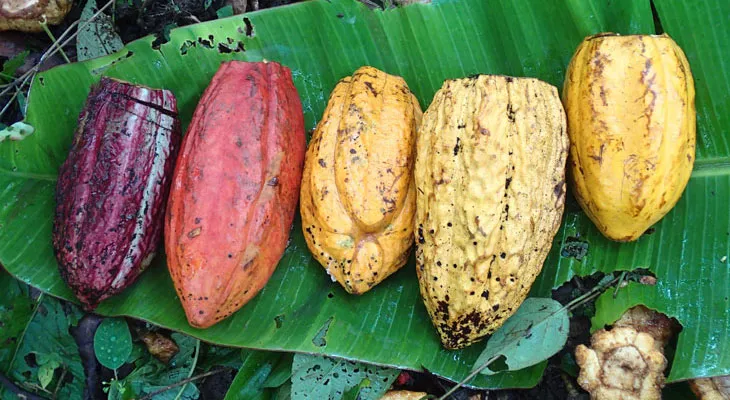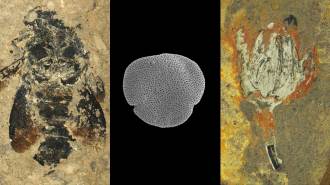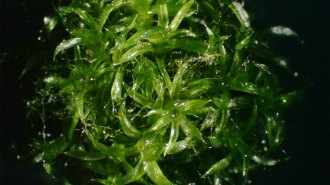The flowers that give us chocolate are ridiculously hard to pollinate
A complicated reproductive system makes pollination a tough job

FLOWERS FOR CHOCOLATE Pale petals curl over a cacao flower’s male parts. Here, two developing fruits, or seedpods (top left), will eventually ripen, housing the seeds that give the world chocolate.
Tatters/Flickr (CC BY 2.0)
It’s a wonder we have chocolate at all. Talk about persnickety, difficult flowers.
Arguably some of the most important seeds on the planet — they give us candy bars and hot cocoa, after all — come from pods created by dime-sized flowers on cacao trees. Yet those flowers make pollination just barely possible.
Growers of commercial fruit crops expect 50 to 60 percent of flowers to make a fruit, or pod, says Emily Kearney of the University of California, Berkeley. In some places, cacao crops manage to be that prolific. But worldwide norms run closer to 15 to 30 percent. In the traditional Ecuadorian plantings that Kearney studies, cacao achieves a mere 3 to 5 percent pollination.
The first sight of a blooming cacao tree (Theobroma cacao) can be “disconcerting,” Kearney says. That’s because most flowers come directly out of the trunk, rather than sprouting from branches as in many other trees. For cacao, special trunk pads burst into little pale constellations of five-pointed starry blossoms. Some trunks, says Kearney, “are completely covered with flowers.”
Those flowers make nothing easy. Each petal curves into a tiny hood that fits down around the male, pollen-making structure. A honeybee trying to reach the pollen would be a useless, giant blimp. Instead, flies not much bigger than a poppy seed, in the biting midge subfamily Forcipomyiinae, crawl up into the hoods and do — something.
But what? The flower offers no nectar for the midges to collect. So far, researchers haven’t even demonstrated that there’s an odor luring in the midges. Some biologists have mused that red spikes on the flowers offer nutritious nibbling for midges, but Kearney knows of no tests of this notion.
Another hitch: 100 to 250 grains of pollen are required to fertilize the 40 to 60 seeds that will make up a cacao pod (resembling a wrinkled, swollen cucumber in shades of purple, yellow or orange). Yet midges typically emerge from a flower hood dappled with just a few to 30 grains of the sticky white stuff.

“If we want to get answers about the cacao pollination system,” Kearney says, “I think it’s the wild individuals that are going to open up the field,” instead of cultivated cacao.
The trees evolved in the Amazon Basin and a northern bit of the South American Pacific coast. There, they often grow in clusters of siblings that a monkey unintentionally planted when sucking pulp from a pod and dropping the seeds.
To Kearney, those frail midges seem unlikely to fly the distance from too-close sibling clusters to unrelated trees that offer better cross-pollination chances. So she wonders: Could the cacao with its coy reproductive system have a clandestine, strong-flying native pollinator species that scientists just haven’t noticed?






